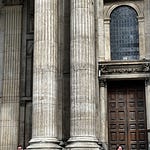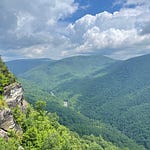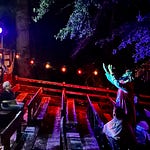Thanks to the generosity of a lot of people, I’ve done a lot of traveling this summer, as some of you know. First to Iceland, then Taiwan, then Oak Island, then Scotland. I’m excited to, perhaps in a few weeks, do a little show and tell with you all especially about the Taiwan trip, where I spent time with the Taiwan Episcopal Church, engaging with ministries there, but also leaving plenty of time for walking through temples, eating good food at tables with wonderful people, and really immersing myself in the culture of that amazing place.
When I travel, there’s this little imaginary line I cross over again and again. On one side of that line is me as an annoying tourist who has to get the photo – you know the one I mean – the one everyone takes when they’re in that spot. The other side of that line is me as a wistful pilgrim seeking authentic, maybe even spiritual, experiences and who looks with contempt at all those other tourists and how they’re ruining everything. Both the holy moment and my perfect shot.
I hold both of those identities when I travel. Tourist and pilgrim. And I tread that line both carefully and – at times – carelessly, as I am pulled back and forth between being truly in a sacred, liminal space and the much more artificial performance of that thing.
So it is with the concept of Sabbath in today’s Gospel. Here, we see two different readings of Scripture at work, each on one side of an imaginary line. One doing the holy moment, the other chirping away about that guy over there who is ruining the beautiful picture.
Each of these perspectives – tourist and pilgrim, Jesus and synagogue leader – are readers. And there are many ways to read for beauty and holiness, whether that is in front of a sweeping mountain range or a cathedral or a temple. Or a text like today’s.
There are multiple voices – masses of people over time – all showing up to these wonders. Some are looking for holy encounters. Others are tourists. Others may be looking to capitalize on the constant flow of visitors. And all of them are in each other’s way, each aiming for that perfect moment that might give the impression that they’re the ones with a claim to the wonderful thing before them. Each of them perhaps has to elbow past another so that everyone can get a turn.
Both the synagogue leader and Jesus are leaning heavily into this deeply Jewish reading tradition that Christians have adopted in their own ways over time.
One of the beauties of that Jewish tradition Jesus leans into here is the recognition that reading Scripture requires us to hear different things among the cacophony of voices clamoring both in and with the text. Imagine standing in front of the great vista with great numbers of people who are both pilgrims and tourists, and trying to sort out which ones make sense.
Like a pilgrim in the best sense, it’s the synagogue leader who is looking at the text and hearing those voices and saying, “Friends, this is what our tradition says is holy. And here is how we are to encounter it.” The synagogue leader is one who has shown up to the beautiful site and who does not love that those rascals over there are trampling on the terrain. And I think that is a fair and holy thing to do.
But it is also a holy thing – perhaps especially in the Jewish tradition as I understand it – to be a different kind of reader of the holy. To emerge from the great noise and bustle of the crowd as a voice that notices other things. Just as Jesus is doing here.
I’ve seen it a time or two in my travels – and maybe you have, too – what happens when we recognize the holy moment we are seeking can only be found by looking in the other direction. This is a rewarding practice, by the way. To get to the view of the magnificent castle up on the hill – the great thing before us – the perfect shot and to, instead, turn around.
What we see when we do that as Jesus does is to look at the faces of people. Their bodies. Their experiences. What they’re carrying with them.
Those faces and bodies will never be captured in the perfect shot or the sense of awe some of us go searching for. And all sorts of other discoveries.
One such discovery for me in this text: a purpose of Sabbath is to be renewing, not merely renewed. The rest and goodness embedded in Sabbath is meant to be available to all – tourists and pilgrims alike. Shared. Our renewal, not just my renewal. Our experience, not just my perfect picture. This is where Sabbath is distinct from time off. From a great vacation. From a self-care day. Or even some holy pilgrimage. In our Eucharistic Prayer C, which we’ve been praying over the Summer each week that we gather at the Table, we encounter these words: Deliver us from the presumption of coming to this Table for solace only, and not for strength; for pardon only, and not for renewal. What I encounter in the story today is that impulse being acted upon: strength and renewal made real. What I also encounter as a part-time tourist, part-time pilgrim is that many of us have deep longings to come closer and closer to the wonderful things before us. That’s why some of us are here today, I think.
But it’s a question, isn’t it? What happens when here, in front of this text or whatever tradition speaks to us or whatever wonderful, transcendent thing it we’re seeking, and we turn around? Who is it we’ll notice?
Today, we see a woman. You know the one. She hasn’t been able to experience a Sabbath fully in eighteen long, haunting years. Maybe ever. One for whom the journey of even a short distance might feel impossible. Or wrapped up in unattainable privilege. Bound by a spirit that somehow draws her gaze down and away from the beautiful thing we’re all there to see. I get the sense that this traveling baggage she’s been carrying is heavy. I have known many people like this. I have been one. Like a pilgrim, I have sometimes shown up to the place people say is wonderful and I have been unable to find wonder. Maybe you have, too.
Jesus sees that woman. And invites her into the Sabbath with those of us who take it for granted that she, too, may add her voice to the bustling chorus after years of pain.
That’s the miracle of this, after all. Right in front of us when we look the other direction. Things coming into new life in bodies we do not expect and sometimes cannot see.
God’s hands are doing a mighty work. What do you see?










